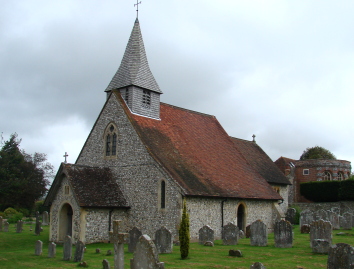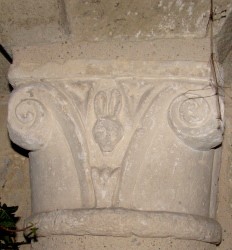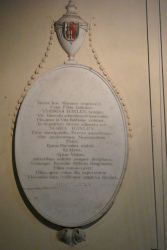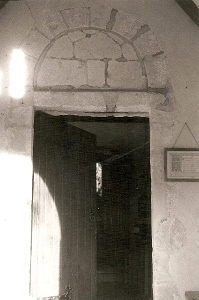Eartham – St Margaret
The church dates from around 1100, including the chancel arch, whilst the chancel and south aisle are early C13. There was much rebuilding in 1869.
Eartham church has developed from a small two-cell structure, probably of c1100. Its history is complicated by C19 restoration, amounting in many respects to rebuilding, but the east and west walls of the nave retain old work, showing the dimensions are unchanged. The round-headed west doorway has a square lintel and a plain tympanum of ashlar. The chancel arch (now the centre one of three) has a head of two unmoulded orders, of which the inner rests on carved capitals, derived ultimately from the Corinthian capital. Two volutes are replaced by a man’s head to the south and a rabbit or hare to the north. These, with the relatively broad proportions, are the best indication of a date around 1100 and it has been suggested (www.crsbi.ac.uk retrieved on 1/4/2013) that the closest parallel in Sussex is the probably slightly earlier work at Stoughton, though that is on an altogether larger scale. Adelaide Tracy (I p100) in 1850 shows recesses on either side of the chancel arch in place of the C19 side-openings, the north one pointed and the other round-headed. In the pointed one was a small squint and both would have been for nave altars. An adjacent corbel was to support the rood-beam.
In the early C13 a narrow south aisle was added, with a two-bay arcade. Its unusually broad arches are, though pointed, only slightly chamfered and seem too large for the responds and abacus of the round pier, which is in a lighter stone. The aisle can never have been more than a passage and Quartermain ((W) p95) shows a round-headed west lancet and a blocked south doorway, as today. On the evidence of the Sharpe Collection drawing (1805) the latter was then the entrance. The chancel, which was also rebuilt in the C13, had then as now only one east lancet and the east wall is probably mostly old.
In the chancel, Adelaide Tracy shows C14 trefoil-headed side-lancets (I p99) which have since been renewed and an ogee-headed lowside which has gone. She also shows C15 two-light square-headed windows in the north nave wall. A four-centred west window with rather nondescript tracery, which Quartermain shows high up, could have been altered from a C15 or C16 original.
Later changes included a large north nave window with elliptical head, shown by Adelaide Tracy. According to Dallaway (I p146) the chancel arch was ‘neatly repaired’ by William Hayley (see under monuments below), probably shortly before 1800, but this is not apparent. At a restoration in 1869 (Elliott and Pritchard p238), H Woodyer replaced all roofs and windows; those in the north wall of the nave became lancets and he altered the chancel ones. A new west window in C14 style is as high up as its predecessor, because of a large west porch. The most conspicuous change inside was his conversion of the recesses either side of the chancel arch into round-headed openings, improving visibility, but changing the appearance of the interior. His shingled bell-turret replaces a boarded one shown by Adelaide Tracy.
Fittings and monuments
Font: Round, by Woodyer, 1869 (ibid).
Glass:
1. (South west chancel single light) J Hardman and Co (The Good Shepherd), 1869 (Hardman index). Were the attribution to Hardman less certain, its old fashioned design could easily be by one of the numerous commercial purveyors of glass at the time.
2. (North chancel, second window) Clayton and Bell, 1891 (www.stainedglassrecords.org retrieved on 11/2/2013).
3. (North nave, first window) F C Eden, 1934 (WSRO Par 74/4/5). Plain almost uncoloured medallions.
4. (North nave, second window) W Aikman, 1946. Heraldic in nature (www.stainedglassrecords.org retrieved on11/2/2013).
Monuments:
1. (Behind the organ) William Huskisson (d1830) who lived in the parish. He was a statesman and the first man in England to be killed in a railway accident. A plain tablet with a lengthy inscription.
2. (West wall, north side) Thomas Hayley (d1800 aged 20). By J Flaxman (SAC 97 p86). Hayley was the natural son of the poet William Hayley (see under Felpham) and a pupil of Flaxman, who dedicated the memorial to ‘his beloved scholar’. It shows an angel holding a quill and wreath.
Source
1. W D Peckham: St Margaret, Eartham, SNQ 9,2 (May 1942) p41
Plan
Measured plan by W D Peckham in VCH 4 p154







